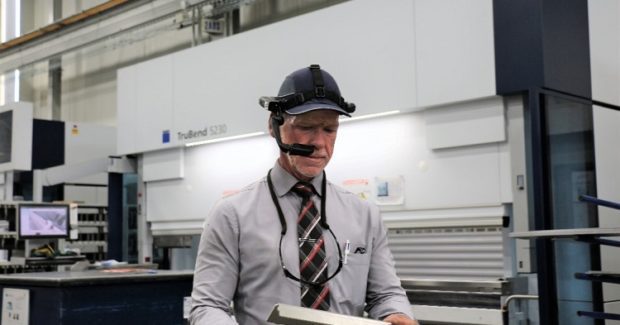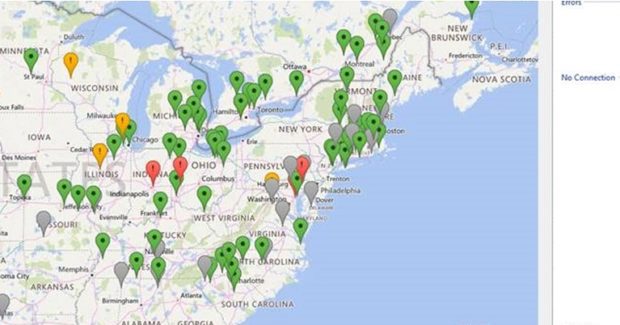Technical Service in the Era of Industry 4.0
As machine tool manufacturers work on enabling technology to make the Smart Factory possible, the field of machine service and support has started to drastically minimize the window of lost productive time that shops must deal with.
Posted: February 14, 2019
It’s no secret that manufacturing technology is getting smarter with every passing year. These days, the buzz behind Industry 4.0 is mostly centered on how advances in communications technology and software development are enabling factory processes to become more interconnected and automatic. While “smart” machinery and software systems communicating in real-time and working with a high degree of automation increases efficiency and productivity, it is important that advancing technology also addresses another critical aspect of factory management: technical service. Real-world implementation of Industry 4.0 concepts brings with it some challenges. For example, capacity planners and operations managers are scratching their heads on how to adapt the latest and greatest software platforms into existing production. Yet at the same time, these platforms have introduced some incredible opportunities for information sharing.
Machine tool manufacturers that are working on the enabling technology to make Smart Factories possible are also working to bring technical support and troubleshooting for machines and software into the Industry 4.0 era. Here we will look at some state-of-the-art examples of how the Internet of Things (IoT) is revolutionizing machine tool service.
Let’s start with a classic tech support scenario that technology users and support personnel deal with every day. Imagine a machine tool on your factory floor has experienced an error that halts production. A call from an employee responsible for the machine is made to the equipment manufacturer’s technical support hotline and discussion about the error begins. Based on the information available, the technical support representative identifies some troubleshooting steps to perform: in this example, we need to open a switch cabinet on the machine, locate a piece of electronic hardware in the cabinet, and note the condition of certain status lights which could accurately identify the fault. Assuming there is no telephone available right at the machine tool (which there won’t be in many cases), the employee working to resolve the fault now must disconnect from the tech support call and go out to the factory floor to perform the troubleshooting steps – though telephones are an extremely useful tool for communication, we have immediately run into a limitation.
Even with mobile phones being ubiquitous, cellular service inside metal buildings that are full of metal products and metal equipment can be spotty at best, and landlines certainly can’t be everywhere. A tremendous amount of time is wasted on phone calls, either walking back and forth from the machine to the phone or leaving messages and waiting for return calls. Even worse, suppose that the technical support representative says, “Look for the yellow plastic box with four blinking lights,” but doesn’t realize that, as of six months ago, the vendor of the electronic component changed the plastic box from yellow to green and added a fifth diagnostic light. Now, in addition to the difficulties of back-and-forth phone calls, the employee ends up on a wild goose chase for a component that they’ll never find!
Enter the role of augmented reality technology, or “smart glasses” as they are commonly known. These devices come in a wide variety of form factors, but they all share a common trait: The ability for the user to “see” information overlaid on top of whatever they are looking at with their eyes. Back to our tech support scenario above: Instead of hanging up the phone and heading out to the factory floor to find that non-existent component, our employee connects to technical support using smart glasses. Anywhere that a Wi-Fi signal can be picked up, the smart glasses can maintain a real-time video and audio connection from our troubleshooting employee straight to the tech support representative. Without losing communication, we can go and open that switch cabinet together, with the tech support rep essentially looking over our shoulder the whole time. Immediately upon looking inside, our tech support rep spots the electronic diagnostic lights through the video connection of the smart glasses. Not only do we save the walking and call-back time, but we don’t have to depend on communication that could be misunderstood: technical support can see the diagnostic lights immediately and interpret their meaning without asking a single question.
As if this isn’t already a big improvement, our smart glasses aren’t out of tricks yet. Having rapidly identified the fault, our tech support representative transmits an image onto the glasses’ display showing the user how to reset the fault and resume production. Without ever taking eyes off the cabinet, our user now has clear instructions on how to resolve the problem and can perform the necessary steps to reset the fault while keeping both hands free to do the work. Since IoT really means networked communication is possible between objects (in this case machinery) and software applications, as well as the worldwide internet, we can take troubleshooting that equipment fault one step further: If the machine can communicate its status and it is already connected to a network, why require an employee to record an error and report it to technical service? Why not allow the machine to report the fault to technical service directly over the network? This is exactly what some manufacturers of CNC machinery are beginning to offer their customers – cloud-based, real-time “condition monitoring” of machines in operation.
Allowing machines to report their status directly to a technical service “nerve center” provides a lot of benefits. Instead of waiting for an employee to notice a fault and report it, an error report can be generated the instant that fault occurs. This can make a huge difference in the time it takes to react to and correct a problem, especially in automated, unattended production. Further, as machinery becomes more “self-aware” using sensors and networked intelligence, much of the work of troubleshooting a fault can be done automatically by having the equipment immediately transmit relevant data to technical service professionals for analysis. The ultimate destination of this technology starts to come into focus: Instead of calling technical support to report a problem and begin the process of troubleshooting, technical support can call the user and have diagnostics already performed and a solution to the problem already prepared, possibly before the user has even become aware of the issue.
Obviously, there is still some legwork to be done to make that goal a working reality. Machines must be equipped with a variety of sensors to be able to monitor their own condition, and cloud-based servers have to be equipped with the logic to understand what the machines are reporting and be able to distinguish between ordinary errors (such as an operator deliberately interrupting the machine in the normal course of work) and errors that require attention from technical service. Security concerns also must be thoroughly addressed: Allowing machines to communicate automatically with external computers needs to happen in a way that keeps private information protected. This work is already underway and there are some factories around the world reaping the benefits of machines connected to real-time condition monitoring services. The upshot of these developments in the field of machine service is that when errors happen in production – and we can all agree that errors will happen at some point – the window of lost productive time that we must deal with can be drastically minimized. That’s a very tangible benefit that manufacturers can expect as we move further into the era of Industry 4.0 and the Smart Factory.


















